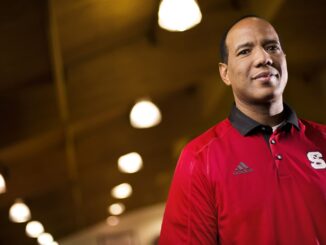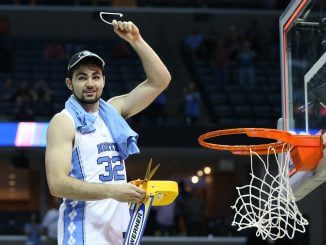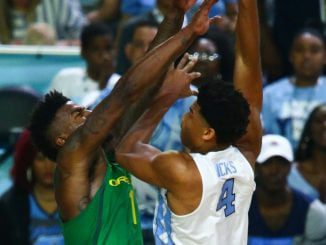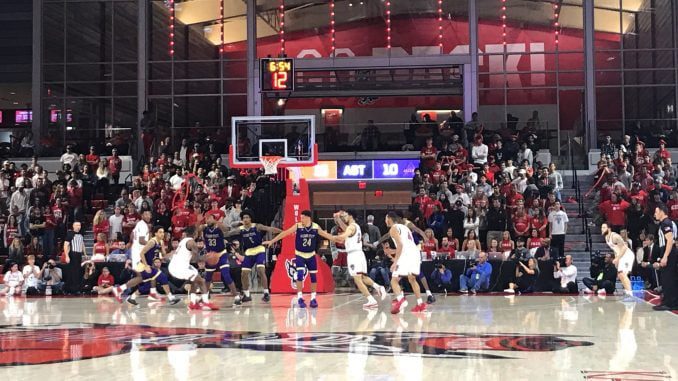
Roy Williams likes to say, only half-jokingly, that today’s generation of college players are so oblivious to the history of their sport that they “think Michael Jordan invented the game of basketball.”
Last week, as North Carolina prepared to play a rare game in its legendary former arena Carmichael Auditorium, one of the Hall of Fame coach’s current players semi-confirmed his theory.
Asked if he was aware of the Tar Heels’ storied history in the building, which includes Jordan’s entire college career, senior wing Brandon Robinson shook his head and pleaded the Fifth.
“No history,” he said. “I’m not going to sit here and lie to you and I am. You can ask Frank Robinson, my dad, and he’ll be able to tell you all about it.”
The younger Robinson and his teammates now have their own memory of Carmichael, albeit an unpleasant one, after playing — and losing — a game against Wofford there on Sunday.
While the 8,800-seat building has gone through an extensive renovation since the UNC men’s team moved across campus to the bigger, more modern Smith Center in 1986, the members of this year’s team at least got a feel for what it was like to play at an arena that was once considered the loudest, most intimidating homecourt advantage in the ACC.
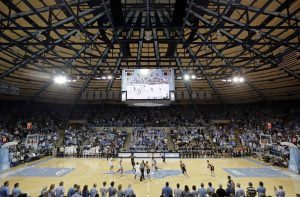
It’s a similar experience to the one players at rival NC State got earlier this season when they played two games at their school’s old on-campus haunt, Reynolds Coliseum.
The only difference there, besides the fact that the Wolfpack won both times — against St. Francis and Alcorn State — is that the players seem to have a better grasp of the things that went on there before their time.
“I think everybody is (aware of it), most definitely,” redshirt junior guard Devon Daniels said after scoring a career-high 23 points against Alcorn. “It’s just a great place to play. I want to say (the fans) are more involved, like they’re closer. It’s a small arena, so the atmosphere is better. I like it a lot.”
Like virtually everything else involving UNC and State, there is a distinct contrast in the way each school approaches the scheduling of games at their renovated former arenas — both of which are now exclusively regular homes of their women’s teams.
While UNC only scheduled Sunday’s game at Carmichael because the Smith Center was being used for December commencement ceremonies, State has begun a tradition of playing at least one “heritage” game at Reynolds every season since it underwent a major facelift in 2015-16. It also played three postseason NIT games there last March.
In addition to the aesthetic improvements and vastly improved sightlines that helped transform Reynolds from a 77-year-old relic to a state-of-the-art gem, State’s $35 million renovation project also added a museum and its Athletic Hall of Fame to the building, along with more restrooms, concession stands and hospitality amenities.
“This is a great venue to play in,” Wolfpack coach Kevin Keatts said. “This is great because everybody is right on top of you and it’s a legendary place. I love playing here.”
Just not every game.
“I’m not giving up on PNC (Arena) because I love PNC,” Keatts said of his team’s full-time home venue next door to Carter-Finley Stadium. “PNC helps us with recruits. It’s a pro arena. It’s a chance to play in front of 20,000 when we sell out. It’s a great place.
“I look at it like this. We’re fortunate to be one of the few programs that has two great arenas to play in.”
UNC is another, but that doesn’t mean Williams is anxious for the Tar Heels to play there again anytime soon.
“There are so many things that go into it,” the UNC coach said. “(Operations manager Clint Gwaltney) and I talked for years about having a game in there, but … there’s no huge plan to do anything like that, that I know of anyway.”
One of biggest problems with playing at Carmichael, Williams said, is fitting all UNC’s season ticket holders and donors into the smaller seating area.
“I mean, budget-wise… you’ve got 21,750 (seats at the Smith Center),” Williams said. “You don’t have to be a nuclear scientist to figure out. We’re going to let 7,000 of you watch this game (at Carmichael). In today’s college athletic world, you need money.”
While the seating area at the old arena is considerably smaller than it is at the Smith Center, there is at least one similarity — thanks to Williams, who was an assistant to Dean Smith when the move was made in 1986.
“When Coach Smith asked the staff, he said, is there anything you guys want in this new building? And my reaction was, I want the closest seat in the Smith Center to be just like the closest seat was in Carmichael,” Williams said. “He said, ‘Well, go measure.’ So I did and came back and gave it to him and supposedly that’s what they did.
“It was just the enthusiasm (of the place), the noise factor, the attention from the crowd was just off the charts.”
Carmichael was just as loud as ever Sunday. UNC even dusted off the old manually operated scoreboards that were the building’s trademark for effect. But all that atmosphere and nostalgia couldn’t offset the absence of injured point guard Cole Anthony and a 16-0 Wofford run.
To put into context the rarity of the Tar Heels’ 68-64 setback, consider that UNC lost only four games to nonconference opponents at Carmichael in the 20 seasons that it served as the team’s primary home.
“I loved the opportunity to play here,” Williams said. “But I’ll play in the damn Red Forest if we play better and be a lot happier.”


